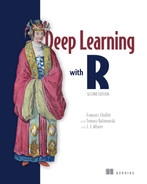preface
If you’ve picked up this book, you’re probably aware of the extraordinary progress that deep learning has represented for the field of artificial intelligence in the recent past. We went from near-unusable computer vision and natural language processing to highly performant systems deployed at scale in products you use every day. The consequences of this sudden progress extend to almost every industry. We’re already applying deep learning to an amazing range of important problems across domains as different as medical imaging, agriculture, autonomous driving, education, disaster prevention, and manufacturing.
Yet, I believe deep learning is still in its early days. It has realized only a small fraction of its potential so far. Over time, it will make its way to every problem where it can help—a transformation that will take place over multiple decades.
To begin deploying deep learning technology to every problem that it could solve, we need to make it accessible to as many people as possible, including non-experts— people who aren’t researchers or graduate students. For deep learning to reach its full potential, we need to radically democratize it. And today, I believe that we’re at the cusp of a historical transition, where deep learning is moving out of academic labs and the R&D departments of large tech companies to become a ubiquitous part of the toolbox of every developer out there—not unlike the trajectory of web development in the late 1990s. Almost anyone can now build a website or web app for their business or community of a kind that would have required a small team of specialist engineers in 1998. In the not-so-distant future, anyone with an idea and basic coding skills will be able to build smart applications that learn from data.
When I released the first version of the Keras deep learning framework in March 2015, the democratization of AI wasn’t what I had in mind. I had been doing research in machine learning for several years and had built Keras to help me with my own experiments. But since 2015, hundreds of thousands of newcomers have entered the field of deep learning; many of them picked up Keras as their tool of choice. As I watched scores of smart people use Keras in unexpected, powerful ways, I came to care deeply about the accessibility and democratization of AI. I realized that the further we spread these technologies, the more useful and valuable they become. Accessibility quickly became an explicit goal in the development of Keras, and over a few short years, the Keras developer community has made fantastic achievements on this front. We’ve put deep learning into the hands of hundreds of thousands of people, who in turn are using it to solve problems that were until recently thought to be unsolvable.
The book you’re holding is another step on the way to making deep learning available to as many people as possible. Keras had always needed a companion course to simultaneously cover the fundamentals of deep learning, deep learning best practices, and Keras usage patterns. In 2016 and 2017, I did my best to produce such a course, which became the first edition of this book, released in December 2017. It quickly became a machine learning best seller that sold over 50,000 copies and was translated into 12 languages.
However, the field of deep learning advances fast. Since the release of the first edition, many important developments have taken place—the release of TensorFlow 2, the growing popularity of the Transformer architecture, and more. And so, in late 2019, I set out to update my book. I originally thought, quite naively, that it would feature about 50% new content and would end up being roughly the same length as the first edition. In practice, after two years of work, it turned out to be over a third longer, with about 75% novel content. More than a refresh, it is a whole new book.
I wrote it with a focus on making the concepts behind deep learning, and their implementation, as approachable as possible. Doing so didn’t require me to dumb down anything—I strongly believe that there are no difficult ideas in deep learning. I hope you’ll find this book valuable and that it will enable you to begin building intelligent applications and solve the problems that matter to you.
